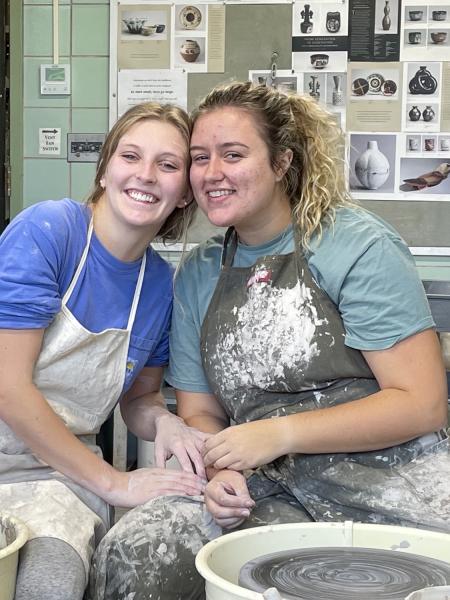
Studio Art
Visual imagination, creative invention.
In the Studio Art program at Mercyhurst University, we emphasize hands-on learning, craftsmanship, and design, and strive for excellence in the production of art. Faculty provide the environment and guidance to for students to develop a disciplined approach to the making of art. The Studio Art major is one of four art programs of study in the Department of Art, Design, and Communication, also including Art Education, Art Therapy, and Graphic Design. All first-year students are enrolled in the same foundation year art classes and have the flexibility to explore these four programs.
Fast Facts
- Studio Art majors can choose to customize their studio courses to focus on areas of study, such as ceramics, digital imagery, painting, and photography, or they can generalize and take a wide range of media courses.
- The Studio Art major is built so that students get a broad foundation and upper-level work in two- and three-dimensional media. 2-D media includes photo, painting, drawing, printmaking, and computer art. 3-D media is focused on ceramics and can be expanded to include printing. Students may also work in mixed media.
- Studio Art majors take the Senior Art Thesis course to develop a portfolio of work that is shown in the Annual Senior Art Thesis exhibition in the regionally renowned Sister Angelica Cummings Art gallery.
- With the flexible curriculum, Studio Art majors are able to try courses in other art major areas, such as Graphic Design, Art Education, or Art Therapy.
- Studio Artists can specialize their degree by pairing their studio major with a second major or minor for a more focused approach. Popular minors include Religious Studies, Graphic Design, Psychology, History, and Art History.
- According to the Bureau of Labor and Statistics, the median wage for artists is $57,560.
- Studio Art majors can work as independent makers; business and gallery owners; window or display artists; floral, set, and exhibit designers; as well as in publishing.
- ACCT 101: Principles of Accounting (3 credits)
- MGMT 120: Principles of Management (3 credits)
- MKTG 162: Principles of Marketing (3 credits)
- DANC 200: Intro. to Arts Administration (3 credits)
- DANC 475: Arts Management Internship (3 credits)
- ART 128: Graphic Design Basics (3 credits)
- COM 240: Digital Video Production (3 credits)
- COM 260: Intro. to Social Media (3 credits)
- ART 321: Intro. to Website Design (3 credits)
- COM 312: Communication & Social Responsibility (3 credits)
- COM 314: Global Communications (3 credits)
- COM 330: Web & Social Media Analytics & Strategies (3 credits) Requires COM 260 to be taken previously or concurrently.
- Art 100 Drawing I (3 credits)
- Art 122 or 123 Art History (3 credits)
- Art 125 2-Dimensional Design (3 credits)
- Art 126 3-Dimensional Design (3 credits)
- Basic Level 2-D Studio (3 credits)
- Basic Level 3-D Studio (3 credits)
- Art Electives (2) (3 credits)
- ART 122 Ancient to Medieval Art History (3 credits)
- ART 123 Renaissance to 20th Century Art History (3 credits)
- ART 128 Basic Computer Design (3 credits)
- ART 223 History of Modern Art (3 credits)
- ART 224 History of Photography (3 credits)
- ART 230 Graphic Design History (3 credits)
- ID 220 History of Interior Design (3 credits)
- ID 221 History of Architecture (3 credits)
- ARTH 125 Art Therapy I (3 credits)
- ARTH 225 Art Therapy II (3 credits)
- ARTH 325 Art Therapy III (3 credits)
- PSYC 101 Intro to Psychology (3 credits)
- Three (3) Approved Electives (3 credits)
- COM 101: Communication in Society (3 credits)
- COM 102: Interpersonal Communication (3 credits)
- COM 260: Introduction to Social Media (3 credits)
- Students must take three additional courses within the Communication Department, two of which must be 300-level or higher
- ARTH 125: Intro to Expressive Therapies (3 credits)
- PSYC 101: Intro to Psychology (3 credits)
- One developmental psychology course (3 credits):
- PSYC 241: Developmental Psychology: Childhood,
- PSYC 242: Developmental Psychology: Adolescence, or
- PSYC 142: Lifespan Development
- Abnormal Psychology (3 credits)
- COM 210: Mindful Communication (3 credits), ARTH 275 (3 credits): Group Practices, or SOC 204: Diversity in Society (3 credits)
- And a least two courses in creative fields or modalities with prefixes ART, ARTH, THEA, DANC, MUS (6 credits) (At least one should be a 200-level or higher)
- ART 128 Basic Computer Design 3 credits
- ART 220 Typographic Foundations 3 credits
- ART 221 Digital Imagery 3 credits
- Four (4) Approved Art and Graphic Design Elective
- ART 106 Photography I
- ART 128 Basic Computer Design
- ART 206 Intermediate Photography
- ART 223 History of Modern Art
- ART 224 History of Photography
- ART 305 Digital Photography
- ART 306 Color Photography
- ART 400 Individualized Studio I
- ART 128: Graphic Design Basics (3 credits)
- ART 221: Digital Imagery (3 credits)
- ART 321: Introduction to Website Design (3 credits)
- COM 260: Intro to Social Media (3 credits)
- ART 225: Computer Illustration Technology (3 credits)
- ART 325: Intermediate Website Design (3 credits)
- ART 326: Advanced Website Design (3 credits)
OR - COM 202: Contemporary Media Literacy (3 credits)
- COM 240: Digital Video Production I (3 credits)
- COM 330: Digital analysis & Strategies (3 credits)
- THEA 110: Acting I (3 credits)
- THEA 245: Script Analysis: From Page to Stage (3 credits)
- THEA 290: Topics in Theatre History (3 credits)
- THEA 401: Practicum (3 credits)
Consists of 21 credits as follows:
2 electives of the following, at least one 300-level course.
Required Courses
Course Choices (9 credits)
Students who are majors may pursue the Minor Electives Cluster in Website Design in the Art Department. In contrast, Graphic Design majors may pursue the Minor Electives Cluster in Communication.
Required Courses
Minor Electives Clusters (Choose one: if courses in the minor cluster are required for your major, please take the opposite cluster.)
Learning Outcomes
- Present, critique, and write about works of art and design using appropriate terminology from history, culture, and contemporary art and design.
- Generate works that demonstrate a productive creative process and exhibit a high level of craftsmanship and technical facility.
- Develop artworks that use elements and principles of art and design.
In the Classroom
The Mercyhurst University Department of Art, Design, and Communication teamed up with the Erie Zoo for an “ExZOOberant Paint Party” in our art studio. The Jungle Crayon Fence surrounds the children’s play area as a memorable and fun piece of personality in the nearby Erie Zoo. Students and faculty from the Department of Art, Design, and Communication led the initiative to host a painting party to give new life to this iconic fence in the zoo area. The entire Mercyhurst community was invited to join in the fun, with students, faculty, and staff helping paint more than 85 crayons with unique designs and names that all adhered to an animal theme. Mercyhurst’s Department of Art, Design, and Communication students love opportunities to be creative in the Erie community, especially the chance to work on unique displays like the Jungle Crayon Fence!
Heather Denning, M.A., LPAT, ATR-BC, ATCS, LSW
Chair, Department of Art, Design, and Communication
Director of Art Therapy
Office: Zurn 121A
Meet the Faculty
Art, Design, and Communication


















